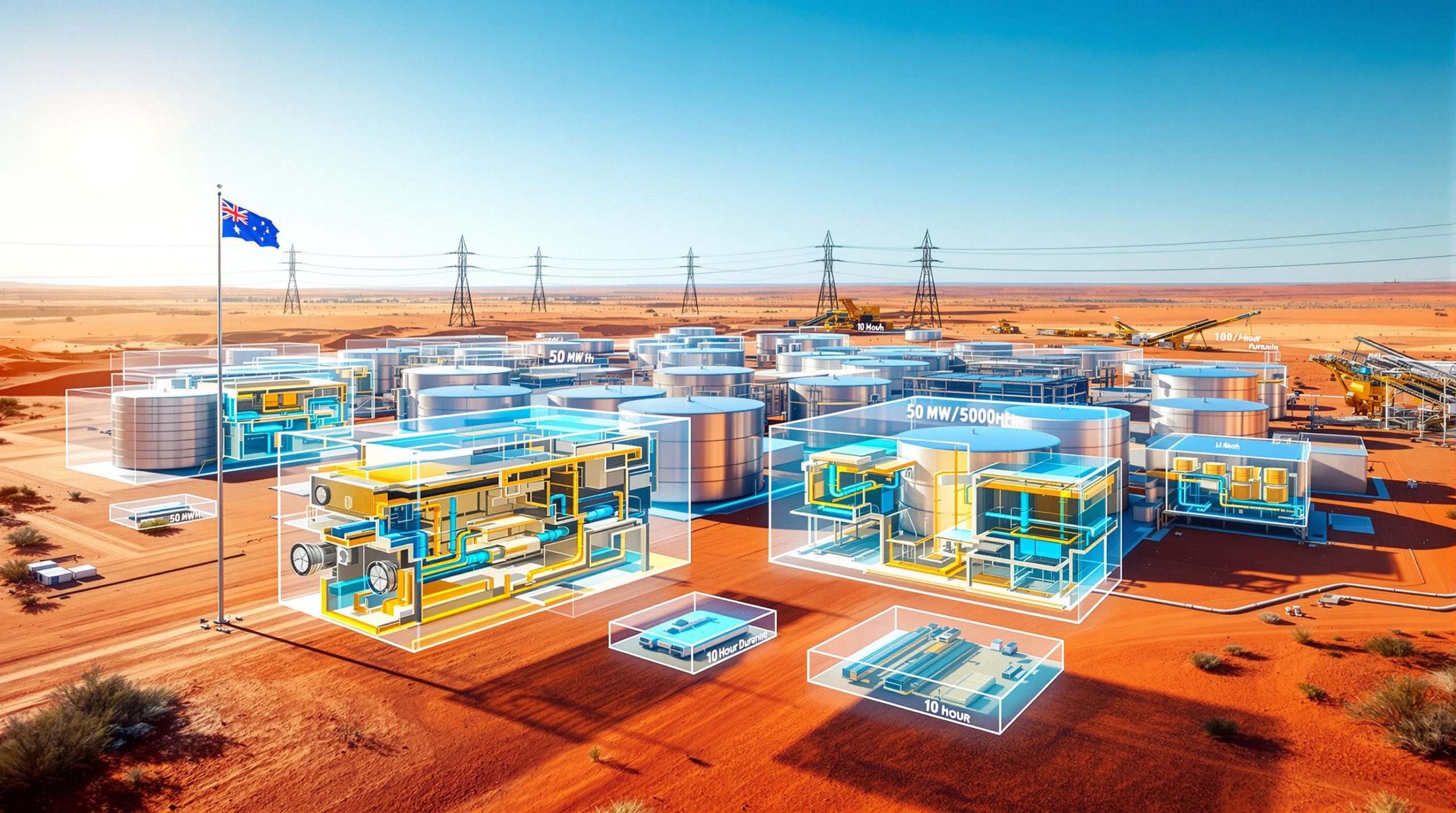Long-Duration Energy Storage Transforms Australia's Remote Mining Infrastructure
The increasing complexity of Australia's energy grid presents unique challenges for remote industrial operations, particularly in regions where renewable energy intermittency intersects with critical infrastructure demands. As mining operations expand across Western Australia's vast interior, traditional energy storage solutions prove inadequate for extended discharge requirements that span multiple operational cycles.
Furthermore, flow battery technology represents a fundamental departure from conventional lithium-ion systems, utilising liquid electrolytes stored in external tanks rather than solid-state chemistry contained within fixed cells. This architectural difference enables unprecedented scalability through tank expansion while maintaining consistent power output ratings, addressing the specific needs of remote industrial applications where reliability supersedes peak performance metrics.
Understanding Vanadium Flow Battery Architecture in Remote Applications
Electrolyte Chemistry vs Solid-State Energy Density
Flow batteries operate through the circulation of vanadium-based electrolytes between separate tanks, creating a system where energy capacity scales independently from power output. Unlike lithium-ion batteries where energy and power are intrinsically linked through cell configuration, flow systems achieve extended duration through increased electrolyte volume rather than additional battery modules.
The Western Australia flow battery project specifications demonstrate this scalability advantage with its 50 MW power rating coupled to 500 MWh energy capacity, delivering a 1:10 power-to-energy ratio that significantly exceeds typical lithium-ion installations.
Key operational advantages in extreme climates include:
- Operating temperature range extending beyond 40°C without performance degradation
- Fire risk elimination through non-flammable aqueous electrolytes
- Maintenance accessibility through modular tank and pump configurations
- Electrolyte recycling capability extending operational life beyond 25 years
Discharge Duration Capabilities for Industrial Operations
The 10-hour discharge capacity represents a strategic shift from peak-shaving applications toward comprehensive energy management for extended operational cycles. This duration enables mining operations to maintain power during equipment maintenance periods, grid outages, and renewable energy lulls that can span multiple days in desert climates.
However, the integration of mining electrification trends with long-duration storage creates new operational paradigms for remote industrial facilities.
Comparative discharge analysis reveals:
| Storage Technology | Typical Duration | Industrial Suitability |
|---|---|---|
| Lithium-ion BESS | 2-4 hours | Peak demand management |
| Vanadium Flow Battery | 6-12+ hours | Process continuity |
| Pumped Hydro | 8-16 hours | Grid-scale balancing |
| Compressed Air | 4-8 hours | Renewable integration |
Technical Configuration Analysis for Mining Region Implementation
Power Infrastructure Requirements in the Goldfields
The Kalgoorlie installation location presents specific technical challenges related to grid connection stability and remote maintenance accessibility. Located approximately 595 kilometres east of Perth, the Goldfields region operates on extended transmission lines vulnerable to weather-related outages and equipment failures.
Consequently, the 50 MW/500 MWh system addresses these vulnerabilities through:
- Grid stabilisation during transmission line switching operations
- Load balancing for variable mining operation power demands
- Emergency backup power for critical mining infrastructure
- Renewable energy storage during high-generation periods
System Integration with Existing Mining Infrastructure
Mining operations in the Goldfields typically operate on 24-hour cycles with varying power demands depending on extraction, processing, and transportation activities. The flow battery system provides energy arbitrage opportunities by storing low-cost renewable energy during off-peak periods and discharging during high-demand operational phases.
In addition, round-trip efficiency considerations become critical for economic viability, with vanadium flow batteries typically achieving 75-85% efficiency compared to lithium-ion systems at 85-95%. However, the extended operational life and lower maintenance requirements offset initial efficiency disadvantages over multi-decade deployment periods.
Supply Chain Development for Integrated Vanadium Processing
From Mining to Manufacturing: The Australian Advantage
The Western Australia flow battery project leverages the state's existing vanadium mining operations to create an integrated supply chain spanning extraction, processing, electrolyte production, and battery assembly. This vertical integration reduces import dependencies while supporting local manufacturing capabilities.
Moreover, developments in critical minerals energy security demonstrate the strategic importance of domestic processing capabilities for energy storage technologies.
Australian Vanadium Limited's involvement demonstrates pit-to-battery integration across multiple operational phases:
- Vanadium pentoxide extraction from existing mining operations
- Electrolyte processing through specialised chemical conversion
- Flow battery assembly utilising locally produced components
- Maintenance and replacement parts sourced from domestic suppliers
Economic Impact of Local Manufacturing Integration
The $150 million AUD ($96.8 million USD) government investment creates multiple economic multiplier effects beyond the immediate battery installation. Local content requirements drive employment across mining, chemical processing, manufacturing, and maintenance sectors.
Furthermore, the development of a strategic minerals reserve supports long-term supply chain security for critical energy infrastructure projects.
Cost analysis reveals approximately $300,000 AUD per MWh of storage capacity, positioning the project competitively with international flow battery installations while maintaining sovereign industrial capability.
"Vertical integration from vanadium mining through battery production creates supply chain resilience unavailable to import-dependent storage projects, particularly critical for remote installations requiring specialised maintenance capabilities."
Regulatory Framework and Procurement Innovation
Two-Stage Expression of Interest Process
The procurement approach utilises a two-stage evaluation structure designed to assess both technical capabilities and local content integration. Stage 1, closing January 30, 2026, focuses on market capability assessment without formal procurement commitments.
Stage 2, scheduled for early-to-mid 2026, evaluates detailed business cases with emphasis on:
- Technical performance guarantees for extended discharge operations
- Local content percentage requirements and scoring methodologies
- Risk allocation between government funding and private investment
- Operational performance metrics and maintenance responsibility frameworks
Risk Management in Remote Deployment
Flow battery installations in harsh desert environments require specialised risk mitigation strategies addressing temperature extremes, dust ingress, and maintenance accessibility challenges. The regulatory framework must accommodate these operational realities through appropriate performance standards and maintenance protocols.
According to industry analysis, the project aims to enhance power reliability in the region through advanced energy storage technology.
Key risk factors include:
- Electrolyte pump reliability in high-temperature environments
- Tank integrity during extreme temperature cycling
- Remote monitoring system connectivity and data transmission
- Emergency response procedures for electrolyte containment
Global Context: Australia's Strategic Position in Long-Duration Storage
International Flow Battery Deployment Trends
The Western Australia flow battery project represents the largest vanadium flow battery installation in Australia, positioning the country within an emerging global market dominated by Chinese manufacturing capabilities. International deployments demonstrate varying approaches to flow battery integration based on local resource availability and grid requirements.
For instance, mining innovation trends highlight the increasing integration of advanced energy storage solutions across the sector.
China's dominance in vanadium processing and flow battery manufacturing creates supply chain dependencies that Australia seeks to address through domestic capability development. The Kalgoorlie project establishes a foundation for reducing these dependencies while developing exportable expertise.
Competitive Advantages in Critical Minerals
Australia's vanadium resources provide strategic advantages for flow battery deployment compared to lithium-dependent technologies relying on increasingly constrained global supply chains. Domestic vanadium production enables long-term price stability and supply security unavailable to imported battery technologies.
The integration of mining, processing, and manufacturing creates a complete value chain supporting both domestic deployment and potential export opportunities to markets seeking energy storage solutions with reduced supply chain risks.
Performance Monitoring and Success Metrics
Operational Excellence in Remote Environments
The project's success will be measured through multiple performance indicators spanning technical reliability, economic impact, and strategic capability development. Key metrics include:
- Grid stability improvements measured through frequency regulation performance
- Renewable energy integration percentages during high-generation periods
- Mining operation power continuity during planned and unplanned outages
- Local employment generation across the integrated supply chain
Technology Cost Reduction Achievements
As the first large-scale flow battery deployment in Australia, the project establishes baseline costs for future installations while demonstrating scalability potential across similar remote industrial applications. Cost reduction through manufacturing experience and supply chain optimisation will determine replication feasibility.
However, long-term performance data will inform future project development across Western Australia's mining regions, agricultural areas requiring reliable power, and remote communities seeking energy security improvements.
Future Expansion Potential Across Regional Networks
Scaling Opportunities in Mining-Intensive Regions
The Pilbara region's extensive iron ore mining operations present natural expansion opportunities for flow battery technology, particularly given the area's renewable energy potential and grid isolation challenges. Similar applications across Australia's resource sector could drive significant demand for long-duration storage solutions.
In addition, trends in battery metals investment suggest growing market interest in energy storage infrastructure projects across mineral-rich regions.
Agricultural regions increasingly dependent on renewable energy for irrigation and processing operations represent additional markets for flow battery deployment, particularly where seasonal energy storage requirements exceed typical battery durations.
Export Market Development
Pacific Island nations facing energy security challenges present potential export markets for Australian-manufactured flow battery systems. The technical expertise and supply chain capabilities developed through domestic deployment create foundations for international project development.
Consequently, the project's demonstration of integrated vanadium-to-battery capabilities positions Australia as a potential technology exporter rather than solely a resource supplier, adding value to mineral exports through advanced manufacturing integration.
Investment Implications for Energy Storage Markets
Market Psychology Around Long-Duration Storage
The shift toward 10-hour discharge capabilities reflects changing perceptions of energy storage value beyond traditional peak-shaving applications. Investors increasingly recognise the premium value of services requiring extended discharge durations, particularly in grid-constrained regions.
Furthermore, flow battery technology appeals to risk-averse investors seeking predictable performance over extended operational periods, contrasting with lithium-ion investments subject to rapid technological obsolescence and supply chain volatility.
Strategic Resource Security Considerations
The project demonstrates government willingness to invest in strategic energy infrastructure development rather than relying solely on market-driven deployment. This approach acknowledges the national security implications of energy storage technology dependence on foreign supply chains.
According to government statements, the initiative aims to establish local manufacturing capabilities for critical energy infrastructure.
Future investment patterns may favour technologies offering sovereign capability development over purely economic optimisation, particularly for critical infrastructure applications in remote or strategically important regions.
Disclaimer: This analysis involves forward-looking projections regarding technology development, market trends, and economic outcomes that may not materialise as anticipated. Investment and policy decisions should consider multiple scenarios and risk factors beyond those discussed in this assessment.
Seeking Opportunities in Australia's Energy Storage Revolution?
Discovery Alert's proprietary Discovery IQ model delivers real-time notifications on significant ASX mineral discoveries, instantly empowering subscribers to identify actionable opportunities in the expanding critical minerals and energy infrastructure sectors. Begin your 30-day free trial today and position yourself ahead of the market as Australia's energy transformation creates new investment opportunities.




